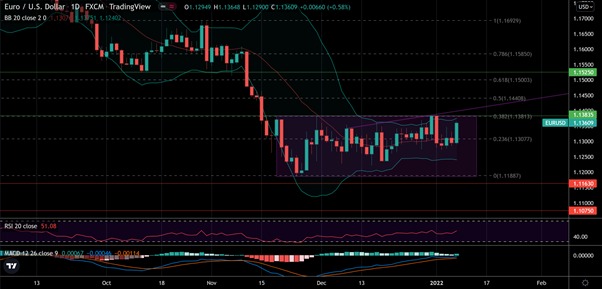EURUSD Euro could breakout following consolidation phase
- 2022-01-10

The U.S. economy added a meagre 199,000 jobs in the final month of 2021, well below market expectations of 400,000. Job growth averaged 537,000 per month in 2021 and the economy added a record 6.44 million jobs last year. Nonfarm employment has increased by 18.8 million since April 2020, but is still down 3.6 million, or 2.3 percent, from its pre-pandemic level in February 2020.
The impact of the rapid spread of the omicron variant of coronavirus on the labour market is still uncertain, as the December report only covered the first two weeks of the month, before the worst of the outbreak that began around Christmas.
These weaker numbers are not enough to question the restrictive turn of the Fed affirmed with the release of the FOMC minutes last Wednesday. The risk is that the economy will slow down, and inflation will rise, a scenario that the markets do not like.
At the same time, the eurozone’s annual inflation rate accelerated for the sixth consecutive month to a record 5% in December 2021, up from 4.9% in November, according to preliminary estimates. The figures compare with market forecasts of 4.7 percent. December also marks the sixth consecutive month that inflation remains above the ECB’s 2 percent target, as supply chain disruptions and high energy costs continue to weigh, though central bank officials have reiterated that the current spike is temporary. This is a line the Fed used to take before it was abandoned.
If the monetary situation in Europe follows the same path, now that the health situation has also deteriorated in the United States, then we could see a narrowing of the rate differential between the two zones that would allow the euro to regain ground against the greenback. Indeed, the rate hike in the U.S. is the most important factor that has contributed to the rise of the greenback.
The EURUSD is locked in a horizontal consolidation channel in a medium-term bearish trend below the descending oblique. The RSI around the 50 level and rather flat confirms this short-term neutrality.
The signal for the end of the decline and the bullish reversal will be given by the exit of the channel and the crossing of the oblique. The current period would thus be a distribution phase. We will therefore have to monitor the behaviour of prices in contact with this double resistance.
If the euro should fail, a return to the bottom of the channel and the support at 1.1168 would be possible. A new leg down would take shape under this support zone. Traders should wait and monitor the price action towards the 1.1383 level for signs of weakness before entering into any long positions.
Support & Resistance Levels:
R3 1.1585
R2 1.1500
R1 1.1383
S1 1.1300
S2 1.1887
S3 1.1163
Analyzed by: Mr.Thibault Moirez, Independent Analyst
